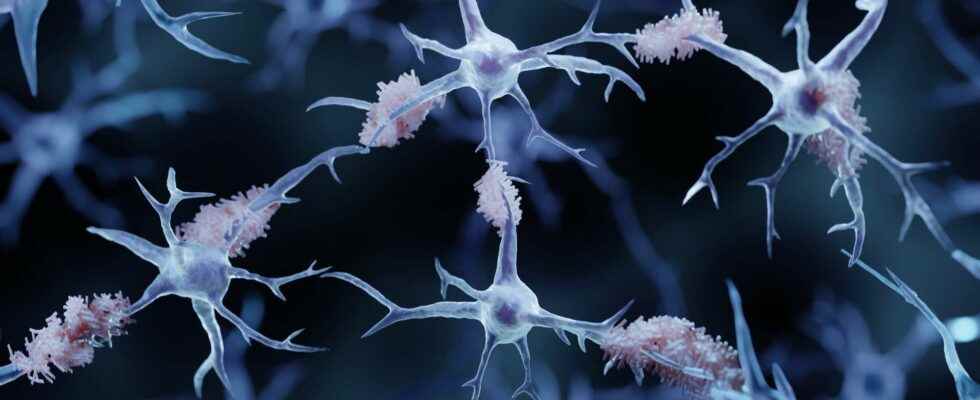You will also be interested
[EN VIDÉO] Soon a blood test to detect Alzheimer’s disease? A blood test to detect Alzheimer’s disease that could be done at your doctor’s office would soon be possible.
The identification of risk factors genetics of Alzheimer’s disease is a crucial research issue to better understand the pathology and deal with it better. The progress of the analysis of the genome human, coupled with the implementation of large pan-genomic association studies — these studies consist of analyzing the entire genome of thousands, or even tens of thousands of individuals, healthy or sick, to identify risk factors genetic associated with specific traits of the disease — today allow important advances in the field.
Alzheimer’s disease is the most common of dementias, affecting approximately 1,200,000 people in France. It is a complex multifactorial pathology, which generally appears after the age of 65 and for which there is a strong genetic component. The majority of cases would be caused by the interaction of different factors of predispositions genetics with environmental factors.
If the disease is better and better understood, there is currently no treatment to cure it. The drugs available are mainly aimed at slowing down cognitive decline and reducing certain behavioral disorders. One of the major challenges of research is to better characterize the genetic risk factors of the disease, to better understand its origins by identifying the physiopathological processes involved (all the functional problems caused by a disease or a particular condition), and thus propose new therapeutic targets.
As part of an international collaboration, and under the coordination of Inserm research director Jean-Charles Lambert, researchers from Inserm, the Institut Pasteur de Lille, the Lille University Hospital and the University of Lille led a study genome-wide association Genome-wide association studyGWAS) on the largest group of Alzheimer’s patients set up so far — the researchers here looked at the genetic data of 111,326 people who received a diagnostic Alzheimer’s disease or having relatives affected by the disease and 677,663 healthy “controls”. These data come from several large cohorts European countries grouped together within the consortium European Alzheimer & Dementia BioBank (EADB).
Encouraged by progress in the analysis of genomethese studies consist of analyzing the entire genome of tens of thousands, or even hundreds of thousands of individuals, healthy or sick, to identify genetic risk factors associated with specific traits of the disease.
With this method, the scientists here were able to identify 75 regions of the genome (called locus), associated with Alzheimer’s, 42 of which had not previously been implicated in this disease. ” After this important discovery, the rest of our work consisted in characterizing these regions of the genome that we had identified to give them meaning in relation to our biological and clinical knowledge, and therefore better understand the cellular mechanisms and the processes pathological at work “, emphasizes Jean-Charles Lambert.
Highlighting pathological phenomena
In Alzheimer’s disease, two pathological cerebral phenomena have already been well documented: the accumulation of beta-amyloid peptides and the modification of Tau, a proteinwhich is found in the form of aggregates in the neurons.
Scientists here have confirmed the importance of these pathological processes. Indeed, their analyzes of the different regions of the genome confirm that some are involved in the production of amyloid peptides and in the functioning of tau protein.
Moreover, these analyzes also reveal that a dysfunction of immunity innate and the action of microglia (immune cell present in the central nervous system which acts as a “garbage collector” by eliminating toxic substances) is at work in Alzheimer’s disease.
Finally, this study demonstrates for the first time the involvement in disease of the tumor necrosis factor-alpha (TNF-alpha)-dependent signaling pathway — tumor necrosis factor-alpha is a cytokine, protein of immune system involved in the inflammation cascade, in particular in tissue damage mechanisms.
These results confirm and strengthen our knowledge of the pathological processes involved in the disease, and open up new avenues for therapeutic research. They confirm, for example, the benefit of conducting clinical tests on treatments targeting the amyloid precursor proteinto continue work on microglial cells, initiated a few years ago, but also to target the TNF-alpha signaling pathway.
The usefulness of the genetic risk score
Based on their findings, the researchers also constructed a genetic risk score that helps to better assess who among people with cognitive disorders, will progress to Alzheimer’s disease, within three years after the clinical demonstration of the disorders. ” This tool is currently not intended for clinical practice at all, but it could be very useful in setting up therapeutic trials to categorize participants according to their risk and better assess the benefit of the drugs tested. », explains Jean-Charles Lambert.
The team now wishes to continue their work in an even larger group to validate and extend their results. Beyond this exhaustive characterization of the genetic factors of Alzheimer’s disease, the team is also developing many approaches of cellular and molecular biology to determine their roles in the development of the disease.
Moreover, since genetic research has for the moment mainly been carried out on populations of Caucasian origin, one of the future challenges will be to carry out the same type of study in other groups to determine whether the risk factors are the same from one population to another, which would reinforce their importance in the physiopathological process.
Interested in what you just read?
